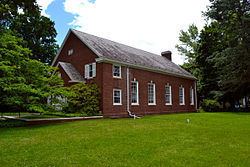Built 1927 Opened 1927 Added to NRHP 27 April 1989 | NRHP Reference # 89000306 Area 2 ha | |
 | ||
Similar Springside, Locust Grove, Top Cottage, Home of Franklin D Roosevel, Church Building | ||
Poughkeepsie Meeting House (Hooker Avenue) is a historic Quaker (Society of Friends) meeting house at 249 Hooker Avenue in Poughkeepsie, New York. It was built in 1927, and is a two-story, rectangular, Colonial Revival style brick building, with a basement. It has a gable roof and projecting entrance pavilion.
It was listed on the National Register of Historic Places in 1989.
Design
The design of the meeting house is unusual, having swayed away from the designs of traditional Quaker meeting houses. It was a result of the reunification of the two groups of Quakers that had initially separated from a schism in 1827, where two thirds of Quakers abandoned the philosophies of their founder, George Fox, and instead turned to the ideals taught by Long Island preacher, Elias Hicks. By 1926, when it was time to construct a new meeting house in Poughkeepsie, the number of local “Hicksite” Quakers was diminishing, so many had joined the Orthodox Quakers. Alfred Bussel, a New York City architect, was chosen to design a meeting house that appealed to all members. Since he had studied at Haverford College, a Quaker school, Bussell was very familiar with the Society of Friends traditions. One branch had suggested a church-like structure with steeple, organ, and stained-glass windows, while the other wanted a more traditional style meeting house, i.e. evoking simplicity, equality, community, and peace. The design therefore was a unity between the two branches, a sign of what was to come with the official reunification in the 1950s. The result is a simple, colonial revival building without stained-glass or any sort of liturgical ornamentation or symbols, as per Quaker tradition, but had a single front door (Quaker meeting houses had separate entrances for men and women) and an interior layout akin to a church; a central aisle with rows of pews on either side all facing the front of the building.
